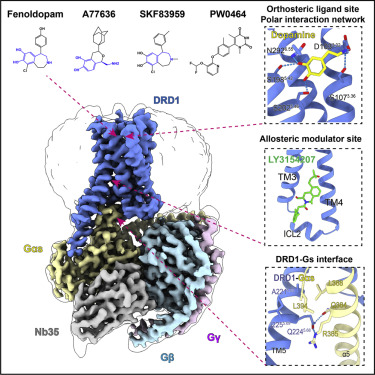
On Feb. 10, 2021, Prof. Shao Zhenhua’s research team from the State Key Laboratory of Biotherapy and Nephropathy Laboratory of West China Hospital, Sichuan University, joined hands with the teams of Prof. Yu Xiao-Sun Jinpeng of Shandong University, Prof. Zhang Lei of Xi’an Jiaotong University and Prof. Du Yang of the Chinese University of Hong Kong (Shenzhen) to publish the latest research result of “Ligand Recognition and Allosteric Regulation of DRD1-Gs Signaling Complexes in Cell (IF: 38.637) online, revealing the ligand recognition and allosteric regulation mechanism of dopamine receptor DRD1.
Dopamine is a neurotransmitter that can bring pleasant feelings to people and plays an important role in the treatment of central nervous system diseases. It regulates many physiological processes through dopamine receptors, such as rewarding, addiction, memorizing, metabolism and hormone secretion. Dopamine receptors include two sub-families--D1 receptors and D2 receptors, in which D1 receptors (DRD1 and DRD5) regulate rewarding, movement and cognition of the central nervous system by activating Gs/Golf and stimulating the production of cyclic adenosine monophosphate (CAMP), and play a beneficial role in peripheral tissues, including the inhibition of inflammatory reactions and the maintenance of dynamic balance of heart and blood vessels and kidneys. In contrast, D2 receptors (DRD2, DRD3 and DRD4) coupled with Gi/Go inhibit cAMP accumulation and regulate different physiological effects. Five dopamine receptor subtypes have high sequence homology and recognize the same endogenous ligand. Important progress has been made in drug development for these five subtypes. However, the mechanism of agonist recognition, ligand selectivity, receptor activation and G protein selectivity among dopamine receptor subtypes remains unclear.
Up to now, the molecular mechanisms of D2 receptor recognizing antagonist ligand and selective agonist bromocriptine activating DRD2-Gi signal transduction complex have been revealed. However, there is a lack of the structural basis of D1 subfamily recognizing ligands, and highly selective agonist drugs can meet the clinical needs for the treatment of Parkinson’s disease and renal injury hypertension. The structural basis of D1 dopamine receptors will provide a theoretical basis for the development of selective agonists.
The research team adopted Cryo-electron microscopy (Cryo-EM) to analyze for the first time the three-dimensional structure of DRD1-Gs complex combined with Catechol-like agonists (antihypertensive drug Fenoldopam, complete agonist A77636 and G protein biased agonist SKF83959), non-catechol-like agonist PW0464, as well as the happiness hormone Dopamine and positive allosteric modulator LY3154207.
The team analyzed the complex structure of dopamine receptor DRD1 and G protein using single-particle frozen cryo-electron microscopy, thus explaining in detail the mechanism of ligand recognition and allosteric regulation of DRD1 and the coupling with G protein at the atomic level. The research will bring a promising future for drug development and treatment of hypertension, Parkinson’s disease, kidney injury and other diseases.
Link to original text: https://www.cell.com/cell/pdf/S0092-8674(21)00071-4.pdf#%20